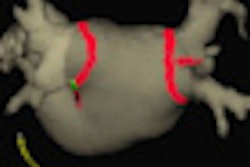SAN DIEGO - Compression of the superficial femoral vein should be added to the two-point compression ultrasound technique for evaluating deep venous thrombosis (DVT), according to research presented Friday at the 2010 American Institute of Ultrasound in Medicine (AIUM) meeting.
In a six-year retrospective review, a Nebraska research team found that compression ultrasound of the superficial femoral vein detected a significant number of isolated DVT. That wasn't the case with the deep femoral vein, however, which has an extremely rare prevalence of isolated clots, said presenter Dr. Srikar Adhikari, an emergency medicine physician at the University of Nebraska Medical Center in Omaha.
Two-point compression ultrasound is widely employed to evaluate the lower extremity for DVT, but only the common femoral vein and popliteal vein are typically compressed using this method. Some sonologists, however, have advocated the compression of additional sites such as the superficial femoral vein and the technically challenging deep femoral vein, Adhikari said.
To determine the prevalence and distribution of deep venous thrombi isolated to different lower extremity veins in patients with clinically suspected DVT, the Nebraska researchers retrospectively reviewed the records of all emergency department (ED) patients who underwent lower extremity ultrasound for DVT evaluation over a six-year period at their tertiary care hospital.
The ultrasound protocol included both B-mode and color Doppler analysis of the deep veins of the lower extremity; compression of common femoral, superficial femoral, deep femoral, popliteal, posterior tibial, peroneal, and calf veins were performed.
Three chart reviewers collected data using a standardized form. Medical records were reviewed for ultrasound findings, ED assessment for additional diagnostic testing, hospital course, and final diagnosis, Adhikari said.
A total of 2,451 patients (1,595 female, 856 male) received lower extremity ultrasound during the study period. The mean age of patients was 60 ± 19 years. DVT was detected in 363 (15%) of the patients.
Isolated deep venous thrombi were found in the popliteal vein in 17 cases (4.6%), in the superficial femoral vein in eight patients (2.2%), and in the common femoral vein in three cases (0.83%).
Only one case (0.28%) had an isolated deep femoral vein clot; that patient had an elevated D-dimer and symptoms that suggested isolated DVT, he said. Chronic DVT was found in 45 cases (12%).
Adhikari acknowledged several limitations of the study, including its retrospective nature and reliance on an ED patient population. Also, data collectors were not blinded to the study hypothesis and results, and potential exists for investigator bias, he said.
Nonetheless, the study results support adding superficial femoral vein compression to the two-point compression US technique, Adhikari said. Isolated deep femoral vein thrombi were extremely rare, however.
"Based on our study findings, at this point we don't recommend that you add the deep femoral vein to your two-point compression technique," Adhikari said.
By Erik L. Ridley
AuntMinnie.com staff writer
March 29, 2010
Related Reading
Narrowing of common iliac vein a risk factor for DVT, March 18, 2010
DVT, pulmonary embolism common with superficial thrombosis, February 17, 2010
JAMA: Single negative US scan can rule out DVT, February 2, 2010
Limits on off-hours DVT ultrasound may be more efficient, November 5, 2009
Two-point US exam keeps up with whole-leg US in detecting DVT, October 9, 2008
Copyright © 2010 AuntMinnie.com




















